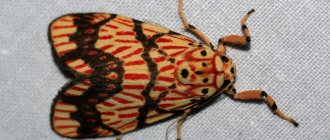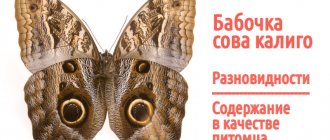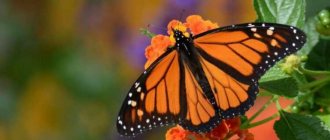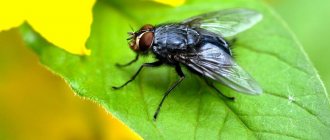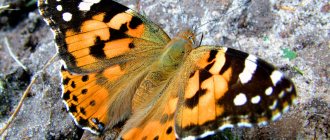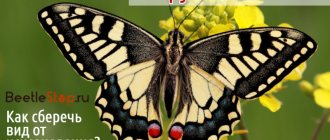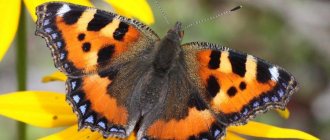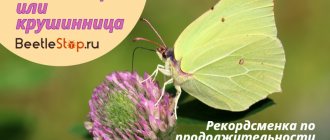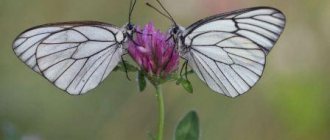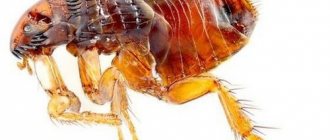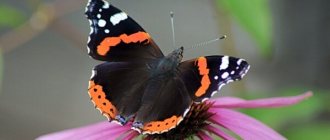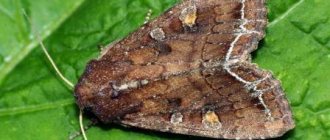Butterflies got their name “bear” from the appearance of their caterpillars, whose bodies are covered with dark, long hairs. These caterpillars really resemble small bear cubs in appearance.
Dipper butterflies are perfectly protected from enemies: their blood is poisonous and bitter, and in addition, the bear has a frightening coloring. Caterpillars are also well protected; in addition to poisonous blood, they have poisonous hairs that provoke a severe allergic reaction in people.
Ursa butterflies come in medium to large sizes. As a rule, they are variegated and brightly colored. Their front wings are triangular in shape, wide and elongated. The wings are decorated with a pattern of stripes, lines and spots. The hind wings are not so variegated, yellow, red and pink. When the bear is in a calm state, her wings fold into a house.
Bear butterfly (Arctiidae).
Their body is thick and completely covered with hairs. The legs are hairy and short. The antennae are comb-like.
Dipper butterflies family features
The family owes its name to caterpillars whose bodies are covered with long, dark brown hairs so thick that they appear to be dressed in bearskin.
Most caterpillars of these butterflies have hairs collected in tufts-tassels, sitting on special protrusions-warts. This “fur coat” protects the bear caterpillars from enemies. Caterpillars lead a relatively secretive lifestyle, feeding mainly on herbs, while lichen bears have switched to feeding on mosses or lichens growing on tree trunks. Dippers are medium to large sized butterflies with a plump body. Large species of this family are very brightly and variegatedly colored, but many smaller species are gray and inconspicuous. The front wings are triangular in shape, the hind wings are smaller. Almost all female bears lead an evening and nocturnal lifestyle. Let's take a closer look at some of the most interesting species.
Kaya bear
One of the most famous representatives of the family is the female bear (Arctia caja). Its habitat includes Europe, Asia and North America. This species is common in central Russia, as well as in Siberia and the Far East. The wingspan of kaya is 6-7 cm. The upper side of the wings is colored in brown and white shades and has an irregular winding pattern, the hind wings are red-orange, with round black or blue spots.
The kaya's proboscis is underdeveloped, so it does not feed throughout its short life.
Ursa Hera
The bear, named after the wife of Zeus, the goddess Hera, is easily recognized by three oblique light lines on the front wings and black spots on the red hind wings. The Hera bear (Euplagia quadripunctaria) lives in Europe (except for the northern regions) and Central Asia. It is found on forest edges and clearings, among shrubs in the zone of deciduous forests. In terms of flight time, Hera is a late-summer species - these butterflies fly in July and August. Unlike most other bears, Hera flies during the day. The caterpillars of this butterfly hibernate.
Human economic activity is leading to the destruction of hera habitats, and today it has become extremely rare in many places.
Transcaspian gloomy bear
This is one of the largest representatives of the family - its wingspan often exceeds 10 cm! The species surprises not only with its size, but also with its way of life - the Trans-Caspian gloomy bears (Axiopoena maura) prefer to live among rocks and in caves! It is also unusual that the caterpillars of this species live very far from caves in mixed-grass steppes.
This amazing butterfly is found in India, Afghanistan, Pakistan, Iran, Transcaucasia and Turkmenistan.
Lady bear
The lady bear (Callimorpha dominula), unlike the previous species, cannot boast of large sizes (its wingspan is only 4.5-5 cm), but it is very beautiful. The front wings are colored in dark shades with light spots, the hind wings are orange or bright red with dark spots.
The lady bear is widespread in Central and Southern Europe, the Caucasus and Transcaucasia. Prefers damp and open places - clearings, grassy slopes, ravines, clearings of broad-leaved forests.
Dipper black and yellow
This is a large bear (Epbestris melfntba), up to 7 cm in wingspan, lives in the tropical forests of Colombia and Brazil, as well as in the equatorial regions of South America. The wings and abdomen of the butterfly are bright, but not variegated, and instead of the usual numerous spots, they are simply painted in two colors - black and golden yellow. After all, the Greek word melfntba means “black-golden-yellow.”
Red-spotted bear
The red-spotted bear (Utetheisa pulchella) is a relatively small species, found in southern Europe, Africa, Central and South Asia. It got its name from the bright pattern on its wings. This rather rare species is mainly found in meadows.
Purple Dipper
The purple bear (Rhyparia purpurata) is found in Europe and temperate Asian regions. Settles on dry heather heaths and sandy soils. Its wingspan is 3-4.5 cm. The front wings are yellow, with individual brownish spots, the hind wings are orange-red.
Ursa is fast
The swift bear (Spilarctia luteum) is widespread from North Africa, through Europe to East Asia. Prefers damp mixed and pine forests. White wings with small black dots have a span of 4-5 cm. These bears fly in June and July during the daytime.
Notes
Arctia (lat.) is a genus of moths from the subfamily of bears of the erebid family, common in the Holarctic region.
Ábashar (Hungarian: Abasár) is a village in Hungary, in the Northern Hungary region, in the Heves County, in the Gyöngyös Jarás. The main settlement of the Matra wine region. The highest viticultural area in Hungary, Mount Sárhegy, is located here.
The Red Book of the Pridnestrovian Moldavian Republic is an official document containing a set of information on the status and distribution of rare and endangered species (subspecies, populations) of wild animals and wild plants and fungi living (growing) on the territory of the Pridnestrovian Moldavian Republic, as well as the necessary measures for their protection and restoration.
The Olschwangi bear (Arctia olschwangi) is a butterfly from the bear family. The specific name was given in honor of the Soviet and Russian entomologist, member of the Russian Entomological Society Vladimir Nikolaevich Olshvang (born 1946).
Butterflies are often brightly and variegated in color, hairy, with a thick body and b.m. large; small species b.h. not brightly colored, not furry and with wider wings. The antennae are short, and in males they are often combed; the eyes are bare (rarely covered with small cilia), the legs are relatively short.
Butterflies often lead a nocturnal or twilight lifestyle. Some species, such as the meadow bear Diacrisia sannio L. and the red-spotted bear Utetheisa pulchella L., are active both during the day and at night. Other species, for example, striped bear Spiris striata L., Kindermann's bear Sibirarctia kindermanni Stgr.
Caterpillars are hairy, in most species they often develop on a large number of different types of herbaceous plants, lichen species - on lichens and liverworts. Many species of the genus Spilarctia Btl. prefer to feed on the foliage of various trees. Pupation usually occurs on the ground in the forest floor in a light cocoon.
Among the bears there are very large species, for example, the gloomy bear with a wingspan sometimes exceeding 11 cm. Among the smallest species of real bears are Epimydia dialampra Stgr. (mountains of Southern Siberia and Mongolia) with a wingspan of less than 2.5 cm. Representatives of lichens are much smaller.
Some species, for example, the red-spotted bear Utetheisa pulchella L., have a very wide distribution - from the islands in the Atlantic Ocean in the west to Myanmar (Burma) in the east; this species sometimes makes long-distance migrations to the north, for example, to Lake Onega. Among the narrowly localized species are endemics of South-Eastern Altai and South-Western Tuva: Dodia sazonovi Dubat., Holoarctia dubatolovi Sald., Palearctia mira Dubat. et Tshist.
There are about 11,000 species known in the world. In Russia there are 73 species of the subfamily Arctiinae, 66 - Lithosiinae, 11 - Syntominae. In the European part of Russia, including the Caucasus and the Urals, there are 42 species of the subfamily Arctiinae, 22 - Lithosiinae, 8 - Syntominae. The greatest diversity of bears (even without lichens) is in South America, where more than 5 thousand species of these butterflies are known.
The fauna of the Faroe Islands is characterized by the remote location of the islands in the North Atlantic Ocean. The Faroe Islands have very few terrestrial species, but relatively many breeding seabirds and marine animals. Some subspecies and variations are endemic. All land mammals were brought to the Faroe Islands by humans. Before the arrival of man, there were no land mammals on these islands.
Sources
- https://tapi-tapi.ru/gusenitsa-medveditsy-pitaetsya/
- https://FB.ru/article/257115/babochka-medveditsa-osobennosti-rasprostranenie-foto
- https://matushka-priroda.ru/blog/nasekomye/2019-02-01-babochka-medvedica.html
- https://apest.ru/nasekomye/babochki/vidy-babochek-i-gusenits/gusenitsa-medveditsi/
- https://www.krasnouhie.ru/babochki-medvedicy.html
- https://ru.wikihow.com/%D1%83%D1%85%D0%B0%D0%B6%D0%B8%D0%B2%D0%B0%D1%82%D1%8C-%D0% B7%D0%B0-%D0%B2%D0%BE%D0%BB%D0%BE%D1%81%D0%B0%D1%82%D0%BE%D0%B9-%D0%B3%D1% 83%D1%81%D0%B5%D0%BD%D0%B8%D1%86%D0%B5%D0%B9-%D0%BC%D0%B5%D0%B4%D0%B2%D0%B5 %D0%B4%D0%B8%D1%86%D1%8B
Reproduction
At the beginning of summer, mole crickets, in preparation for reproduction, construct a complex system of burrows, in the center of which there is a round uterine chamber. After fertilization, the female goes there and lays eggs. In mid-summer, the uterine chambers are already teeming with young larvae. Newborn mole crickets have little mobility. Their body is painted a pale yellow color, which changes after the first molt. Larvae that have just hatched from eggs cannot see. They remain blind until the moment of their first molt. The crop of each larva contains a special yolk, which prevents it from dying of hunger.
Unlike adults, larvae in their “teenage” years resemble grasshoppers, as they can jump and have little weight.
As the larvae grow, they go through up to 9 molts. After leaving the nests, the larvae settle throughout the garden or garden and begin to dig their own burrows. The length of each individual is 2-3 cm; they resemble adult mole crickets in appearance, but do not have wings, which insects grow after the first year of life.
Mole cricket reproduction
Mole crickets begin to reproduce in the spring, after a mass exit from wintering. Their fertilization is spermatophore, like other representatives of Orthoptera. Mating takes place underground. Offspring appear in summer.
For their offspring, insects prepare a home: they dig complex, densely branched labyrinths around the roots of plants and, at a shallow depth (5-10 cm from the surface), arrange spherical nests about 10 cm in diameter. Individuals of both sexes take part in this process. Inside the ball there is a nesting chamber the size of a chicken egg, the walls of which are well compacted. There, the female mole cricket lays from 300-350 to 600 eggs. This is a very important period for the survival of insects, because the offspring located underground are completely dependent on temperature and humidity. The female does not leave the nest, guarding it, maintaining ventilation and temperature. To do this, she clears the passages from the ground, eats up the roots of plants that cast a shadow on the nesting site. Mole cricket eggs are similar to millet grains: oval, yellowish-gray, 2 mm in size.
After 10-20 days, depending on the soil temperature, gray, six-legged, wingless larvae (nymphs) emerge from the eggs, which live in the nest under the protection of the female for 20-30 days. At the end of this period of time, the female begins to freeze and after some time dies. After this, the mole cricket larvae crawl away, dig separate holes and begin to feed.
The development of larvae takes a long time, with incomplete transformation. This period differs in different regions. In the south they develop within 1-2 years, in the north 2-2.5 years. The mole cricket larva is similar to the adult, but with smaller sizes, underdeveloped wings and genitals. In the early stages of development, they are very mobile, nimble and jump well, like grasshoppers. During the period of development from larva to mature adult, mole crickets molt 8-9 times.
Larvae of the common mole cricket. Photo by: Roman Špaček
Swallowtail protection
On the territory of the Russian Federation, depending on the region, there is a low or average number of swallowtails. In the Vologda, Moscow and Smolensk regions, this species is at the stage of extinction, so it is listed in the Red Book. The factors that cause a decrease in the number of butterflies are economic and natural. The latter include unfavorable climatic conditions - low temperature and cloudy weather during mating and laying eggs, damage to autumn larvae by rain and fungal diseases, the influence of early frosts that kill the pupa at the stage of transformation into an adult.
But humans also bring a lot of harm to the swallowtail. Frequent fires in forests and burning of grass lead to the death of butterflies. They also die due to the treatment of agricultural land with insecticides and the capture of individual individuals for collecting. Caterpillars that feed on crops are also destroyed.
A reduction in the number of swallowtails is observed not only in Russia, but throughout Europe. The insects are protected in Latvia, Lithuania and Germany. In these countries, it is prohibited to catch butterflies and collect their caterpillars and pupae. There is strict control over the regularity of cattle grazing and the use of chemicals for treating plants.
There are several interesting facts about this type of insect:
the Germans decided to draw attention to the endangered species and in 2006 made the swallowtail a symbol of the state; colored eyes and tails on the wings are necessary to distract the attention of birds of prey from vital organs; at the end of August, the patterns on the insect’s body fade and become faded; at the slightest alarm, the butterfly begins to quickly flap its wings, trying to fight off the attacker; The intensity of the color directly depends on the climate: the higher the air temperature, the brighter the swallowtail will be.
Family Features
All female bears are relatively large in size. They have a plump body. The front wings are triangular in shape and in most species are brightly colored. The hind wings are smaller and often have a modest coloration. A calm or resting bear butterfly folds its wings like a house, hiding their brightness.
An important feature common to the entire family is toxicity. The blood of these butterflies has a bitter taste, this is for those who did not understand the signal of the motley wings and still decided to attack. Most poisonous creatures look striking, as if warning predators about their peculiarity. It is difficult to digest such prey; it can cause irritation in the digestive system or allergies.
Young people are no less protected. Not only does the bear butterfly caterpillar have bitter, poisonous blood, but its hairs also secrete a strong irritant. Not only should you not chew it, but you shouldn’t even touch it. Thanks to this feature, both adult butterflies and caterpillars have virtually no natural enemies.
American white butterfly
Bear caterpillars are nocturnal. They build spider nests for themselves and live there in small colonies. At night, individuals leave the nests and go in search of food. When morning comes, the caterpillars return to their nests. This lifestyle continues until they grow up. Stronger individuals are able to survive alone.
On a note!
Its homeland is North America, from which individuals migrated to the territory of modern Europe. Today this species can be found in Ukraine, Turkmenistan, southern and western parts of Russia and also in many regions of the Middle East.
Spreading
This species is distributed in the Holarctic region, mainly in the temperate climate zone. The plantain bear prefers to settle in mountainous areas at altitudes up to 3000 m above sea level. Optimal for it are hills with wet meadows or swamps and located on the edge of forests near rivers and streams. In Europe, the largest populations live in the Alps, Balkans and Pyrenees. They are most often observed where lupine or wolf bean (Lupinus) grows.
Butterflies are also found in Asia Minor, Transcaucasia, China, Korea, Mongolia, Japan and North America.
The North American population lives in the area from the Canadian province of Manitoba and Alaska in the north to the state of New Mexico. Isolated populations persist in the US states of Arizona, California and Nevada. Many of them have declined significantly since the mid-twentieth century after reclamation work and other changes in their biotope caused by human factors.
Goldentail
The poisonous butterfly from the family of moths is also called the golden moth and the golden silkworm. In Europe, it is distributed from the shores of the Mediterranean to southern Sweden and Finland, and is found in eastern Russia and North America.
This is a small insect with white furry wings, the span of which reaches only 3-4 centimeters. The butterfly lives in mixed forests, cool orchards and parks, causing significant damage to trees.
The lacewing is poisonous at the caterpillar stage. You can recognize it during this period by its brown color with yellow-white longitudinal stripes and tufts of long brown hair. After touching the caterpillar, it becomes harder to breathe, and the skin develops rashes and scars. Symptoms can be managed with a calcium chloride compress and antihistamines.
Habitat area
Mole crickets live throughout the European part of Russia, with the exception of the northern regions; they can also often be found in Central Asia and the Caucasus. In addition to the common mole cricket, Gryllotalpa africana is also found in Russia. This species lives in the Ussuri region; it is also found in African countries, in India and China. In the summer months, mole crickets dig tunnels 10-20 cm deep from the surface of the earth, and in the winter this insect burrows deep into the soil, to a depth of 1 m.
The mole cricket lives in floodplains of rivers, where this insect is not afraid of floods, because mole crickets not only move well underground and fly, they also swim quite well. Mole crickets love moist soil, so they can often be found in vegetable gardens, greenhouses and greenhouses. This insect appears on the surface more often in the evening and at night, since during the day it hides underground.
Message 2
The mourning butterfly acquired its name due to its dark and mourning coloration.
The top of the wings has a brown-cherry tint with a white or yellow border. The wings have blue spots with a black rim. The lower part of the wings is black and gray. They have small fur over the entire surface of the wings and body.
The butterfly is of medium size and its wingspan reaches 70-90 centimeters.
The mourning butterfly belongs to the nymphalidae family.
The color of the butterfly may depend on temperature changes during the development of the pupa. Sudden changes and drops in temperature can cause darkening of the wings and the disappearance of blue spots.
Lifestyle
The mourning butterfly begins an active lifestyle in April; it can be seen with the first rays of the warm sun.
The butterfly can be seen throughout the summer. The mourning bird lives in Asia, Europe, North America and Japan. It can also be found in Germany, England and Norway.
For life, the butterfly chooses meadows, forests, river banks and even mountains (no higher than 2000 meters above sea level).
Nutrition
Feeding on nectar is not typical for the mourning butterfly. The butterfly liked the fruits that had begun to rot, and was attracted by the smell of fermentation.
The butterfly needs more liquid. Due to this, she will not be able to live away from the reservoir. The mourner can often be seen drinking the sap of birch and other plants. Caterpillars can be found on fruit trees and bushes. Also, the mourning plant can be found in the field on the weeds.
Butterfly breeding
When the mating season begins, males begin to choose clearings and wait for females there. Males feel competition, and they protect the territory from rivals.
A fertilized female can lay up to 100 eggs. Lays on tree branches or leaves.
Already in the spring you can see an invasion of caterpillars on a tree. They are not large in size when hatching (up to 2 millimeters). The caterpillars stay in a heap, and only when closer to pupation do they begin to spread out.
The cupola clings to the leaves upside down. The pupal stage can last 10-12 days. The mourning bird only goes through one cycle during the summer and does not hibernate for several weeks.
The mourning butterfly is not like other types of butterflies. It has a peculiar color that depends on the temperature. Their diet and habitats differ from the lifestyle of other representatives of these flying individuals.
What does mole cricket eat?
Mole cricket is the most common pest of vegetable, fruit, melon, berry, and garden crops. These insects damage roots, tubers, root collars, seeds, underground parts of plants, and sometimes even eat seedlings and young plants. Mole crickets destroy potatoes, beets (table, sugar and fodder), cabbage, tomatoes, carrots, onions, beans, cucumbers, eggplants, peppers, turnips, rutabaga, radishes, pumpkin, watermelons, melons, sweet potatoes, grapes, poppy seeds, hemp, sunflowers , hops, tobacco, flax, strawberries, strawberries, various shrubs, parsley and other umbelliferous plants. Mole crickets damage crops of wheat, rye, oats, barley, corn, rice, millet, soybeans, chumise, paisa, and kaoliang. In the southern regions they destroy more exotic plants: citrus fruits (oranges, tangerines, lemons), tea, cotton, peanuts, cotton. In nurseries and young orchards, trees such as apple trees, pears, plums, cherries, sweet cherries, apricots, and peaches can suffer from mole crickets.
In forests, the insect damages the roots of young oaks, beeches, pines, poplars, spruces and other trees. In addition to plant foods, mole crickets eat earthworms, chafer larvae, ladybugs, dragonflies and other insects.
Photo by: Jeroen Willemsen
Description
Wingspan 50-80 mm. The length of the fore wing is 25–33 mm. The color of the upper side of the wings is brown-white with an irregular sinuous pattern, characterized by great variability. The upper side of the hind wings is light red with five large round spots, the color of which varies from black to bluish. The head and chest are dark, red-brown, the abdomen is red, with black transverse stripes. Butterflies are different. Each individual has an individual pattern on the upper side of the wings. The upper side of the hind wings may be red or yellow, with many or no spots, or plain black.
In individuals developing under the same conditions, color variability is sometimes observed, and sometimes these differences are so great that butterflies can be mistaken for representatives of different species.
Subspecies
Yellow form f. flava
- Callimorpha dominula dominula (Baltic states, Ukraine, Moldova, Western Russia, Europe except south and north)
- Callimorpha dominula lusitanica (Portugal)
- Callimorpha dominula pompalis (Southern Alpine valleys)
- Callimorpha dominula persona (Italy, areas south of the Alps)
- Callimorpha dominula trinacriae (Sicily)
- Callimorpha dominula profuga (Balkans, Western Türkiye)
- Callimorpha dominula rossica (Caucasus, Transcaucasia, Northwestern Iran)
- Callimorpha dominula philippsi (Azerbaijan (Talysh), Northern Iran, Southern Turkmenistan)
- Callimorpha dominula kurdistanica (Southeastern Türkiye, presumably Northern)
Danaid monarch
The monarch is a poisonous butterfly from the genus Danaeidae and the family Nymphalidae. In general, it is distributed in North America, where it is found from southern Canada to Mexico itself. However, the species has been spotted in other regions of the world, such as the Canary Islands, North Africa, Europe and Russia. Butterflies are known for their long-distance migrations to winter, during which they travel up to three thousand kilometers.
The Danaid Monarch has dark orange wings with thick black lines that follow the veining pattern. The outer edges of the wings are edged in black interspersed with white spots. Their caterpillars are colored with yellow, white and black transverse stripes.
Even at the larval stage, insects feed on the leaves of the swallowtail, which contains toxic substances - glycosides. Monarchs themselves do not react to the poison, but their bodies accumulate it in their tissues. After this, the caterpillars become inedible for most birds and small mammals. When pupating, they completely retain their toxic properties, so adult butterflies are also poisonous.
Breeding at home
For breeding butterflies, choose a spacious container with a lid through which oxygen will pass. Cover the bottom with sphagnum moss, under which soil is placed. The height of the flooring is up to 2 cm. A frequent guest of such insectariums is a fluffy caterpillar, the name of which depends on its appearance.
For example, if you have a black hairy caterpillar, what is it called, it is not difficult to find out. If there are yellow dots, it's a mistress. If not, it is most likely urticaria. The furry black and orange creeper belongs to the kaya. It is interesting to watch how a black furry caterpillar pupates; what kind of butterfly will appear in the end will essentially become clear after 8 months.
In order for the insect to hibernate, the temperature drops to +3/+6 °C. Before this, she is fed fresh leaves. Once the pupa emerges, access to light is limited until hatching. After the butterfly appears, cotton wool soaked in a honey solution is used for feeding. As a result, a bear butterfly will appear, the photo of which will become your pride.
kaya (lat. Arctia Caja)
Butterfly protection
Together with moths and moths, butterflies are lepidopteran insects. They have the most varied appearance, reaching from 2 mm to 30 centimeters in size. Most of them have an oval oblong body, a small neat head and a pair of wings covered with microscopic scales. This is what the adult stage of butterflies, the imago, looks like. But to achieve it, they have to go through several stages of development: egg, caterpillar and pupa.
Butterflies do not have sharp stingers, teeth or claws, but they have plenty of enemies. They are eaten by birds, lizards, rodents, toads and predatory insects. In a direct fight, it is difficult for butterflies to resist the enemy and there is little chance of fighting off the attacker. But they can prevent the threat.
Many species benefit from camouflage or deterrent coloration. For example, glass bees copy the appearance of a wasp, and the honeysuckle hawk moth imitates a bumblebee. The crimson ribbon fly skillfully disguises itself as the bark of a tree, and the saturnia scares away enemies with the image of eyes on its wings. There are also poisonous butterflies that can not only frighten, but also harm the enemy. The difficult nature of these insects is usually indicated by bright warning colors.
Literature
- Mikrula. Photos of a butterfly.
- M. P. Cornelio. School atlas - identification of butterflies. M., Visit. 1986.
- Biology. 7th grade. V. M. Konstantinov, V. G. Babenko, V. S. Kuchmenko, Ventana-Graf, 2009.
- P. Marikovsky “To the young entomologist.” M.: Children's literature, 1978.
An Indonesian posted on his Facebook a video of a strange-looking creature that looked like a hybrid of a moth and a spider with furry legs. Commentators write that they would rather burn down their house than be near this creature. True, it turned out that this is not a monster from another planet, but a very ordinary insect before mating.
An Indonesian resident, who calls himself Gandhik on Facebook, tickled the nerves of his subscribers by sharing on Facebook a photo of a strange creature that looked like a butterfly from another planet.
After seeing the picture, people did not understand why this creature was still not on fire. Although, as the experience of a woman from Kansas shows, this is true.
“WHAT THE HELL IS THIS AND WHY IS IT STILL NOT BURNING?”
“OH GOD NO, I WILL BURN THE WHOLE COUNTRY WHEN I SEE THIS CREATION.”
People did not understand what kind of creature was in front of them, but they guessed that it was a hybrid of a spider and a moth. Or moths with caterpillars. Most people didn't want to face him anyway.
“I’d rather be dragged into hell than face this.”
“I’ll have to be revived if I step on this.”
For those who have very strong nerves, there was also a recording attached to the post where a mysterious creature moves its paws.
The video captured a bear butterfly (in Latin the name sounds like Creatonotos gangis). According to the Daily Mail, such hairy legs on these insects cannot always be seen, but only during the mating period.
With the help of these tubes - coremates filled with blood or air - male butterflies secrete pheromones. The hairs, of which there are about 3 thousand on each tube, help distribute these odors.
The size of the coremates depends on how many leaves of poisonous plants the male ate when he was a caterpillar.
But even when Facebook users found out what kind of creature was in front of them, their sympathy for him did not increase.
“Yes, it’s worse than a spider.”
"It's horrible!!! Why does this exist?!!! I would leave wherever it was and never return.”
Such butterflies are found in Asia and Australia, and now people doubt whether to go to this country. After all, there you can also stumble upon fluffy spiders, which at first glance...
“Look, honey, this is why we don’t have to go to Australia.”
But it’s not just insects that give Internet users nightmares; sea creatures can also give spiders and bear butterflies a run for their money. This fisherman from Murmansk regularly posts photos, and subscribers can’t tear themselves away from them.
Lifestyle
The favorite habitats of Callimorphadominula are mixed or sparse deciduous forests. They often settle in bushes, along road ditches, and on the banks of streams. Butterflies become active after dark. During the day they hide in damp, shady places. But there are exceptions to the rules; sometimes adults can be seen during the day, when moths fly over flowers, collecting nectar from umbrella plants.
The moths fly in June-July. The species is sedentary; males and females do not spend much time looking for a partner.
After mating, eggs are laid on the main food plants of the caterpillars:
- stinging nettle,
- yasnotka,
- buttercup,
- geranium.
There are several subspecies of Callimorphadominula living in Europe and Asia:
- C. d. philippi – Azerbaijan, northern Iran,
- C. d. rossica – Caucasus. Transcaucasia,
- CD persona – Italy.
These are just a few subspecies. Also interesting is the yellow form of the female bear f. flava.
Defense mechanism
The species has a weak flight, so catching a moth is not difficult. At the same time, they do not have many natural enemies. This is due to the presence of poison in the body of insects. The hemolymph of the imago is bitter; not many birds and reptiles like it. The protective mechanism is present not only in adult representatives of the species, but also in larvae. Long and thick hairs are a decoration, and a kind of shield from predators. Even in humans, they can cause an allergic reaction if you frighten the caterpillar by picking it up.
Information. The bright colors of the wings warn animals about the danger of the lady bear to their health.
Coloring as camouflage from predators
Camouflage from predators
A huge number of animals use their coloring to blend in with their environment. Thus, animals living in trees may be colored to match the color of the bark or have body patterns that help them get lost in the foliage. Land animals often have a gray-brown coloration, which helps them move undetected on the ground. The body of animals living among the snow is often covered with white fur, which helps them become invisible against a white background. Many animals living in the jungle have spotted colors. This protective coloration is also known as cryptic coloration. Let's now look at the most interesting animals that use cryptic coloration.
Medvedka description and photo. What does a bear look like?
Mole crickets are large insects. The length of their body varies from 3.5 to 5 cm, and the thickness reaches 1.2-1.5 cm. The body of the cabbage plant is colored silky brownish-brown on top, and brownish-yellow on the bottom. The insect's body is covered with tiny hairs.
Photo credit: Natasha Wright, Cook's Pest Control, Bugwood.org
The head of the mole cricket has a prognathic, or straight, position in relation to the body. Its axis coincides with the axis of the body, and the oral organs, which are powerful jaws, are directed forward.
Near the jaws there are 2 pairs of tentacles.
Photo by: Frank Dorsman
The large, clearly visible eyes of the mole cricket have a facet structure and are located on the sides of the head.
Thread-like antennae grow on the head of the insect, slightly extending beyond the pronotum. They are shorter compared to the whiskers of other representatives of crickets.
Photo credit: Katpatuka, FAL
The large and flat pronotum of the mole cricket with the lateral parts (blades) hanging down is a distinctive feature of the insect. The midthorax and metathorax of the insect are connected. The head and front part of the animal's body are covered with a dense chitinous shell - a device for pushing and compacting the earth when digging holes. Because of this shell, the mole cricket resembles a crayfish.
The abdomen of the cabbage plant is thick, reaching 1 cm in diameter, consists of 10 tergites and 8-9 sternites. The apex of the abdomen has anal and genital plates. Females do not have an ovipositor. The last segment of the abdomen has long, flexible cerci, or caudal appendages, covered with small hairs, resembling antennae in appearance.
Photo credit: Clemens Stockner, CC BY-SA 3.0
Mole crickets have 2 pairs of wings:
- The forewings are transformed into short and leathery elytra, covered with thick veins. In length they reach only the middle of the abdomen. The left elytra of insects from the cricket superfamily is always covered by the right one.
- The hind pair are long, wide, transparent, membranous wings with fine venation. In a calm state, they are folded like a fan under the elytra and extended along the abdomen in the form of cords. During the flight of an insect, the hind wings take an active part, while the elytra are involved to a limited extent.
Males differ from females in the venation of their elytra. There are also wingless individuals of both sexes, but they are less common. By the way, the larvae do not have wings.
Photo by: George Chernilevsky, Public Domain
The mole cricket has 3 pairs of limbs, each of which consists of a coxa, trochanter, femur, tibia and a 3-segmented tarsus.
By the way, the auditory apparatus (or organ of hearing) of the mole cricket, like that of many other chirping orthoptera insects (grasshoppers, crickets), is located on the shins of the forelimbs and has an oval or narrow slit-like shape.
The hind legs of the insect are strong and designed for movement; there are 1-4 spines on their inner side. The claw-like forelimbs are a digging apparatus. The thigh and lower leg are greatly expanded, and the tarsus is shortened. On the shin there are 4, and on the tarsus there are 2 black spike-like teeth, with which the mole cricket crashes into the ground.
There are auditory openings on the front legs of the mole cricket. They have an oval or narrow-slit shape.
Photo by: Pavel Korzunovich (PaKor)
A set of problems for the full-time round of the school stage of the Olympiad for grade 8
Problem 8-1
Who seeks will always find!
At the beginning of the twentieth century, geologists encrypted the discovery sites of valuable metal ores on maps using the coordinates of chemical elements in the Periodic Table. The Arabic numeral indicated the period number, and the Roman numeral indicated the group number. In addition, the records also contained letters of the Russian alphabet - A and B. On one of the old maps they found the following designations: 4VIB, 4VIIIB2, 6IB, 6IIB. Exercise:
Decipher the geologists' notes.(2 points)
Problem 8-2
A light body that can be forged. M.V. Lomonosov
One of the chemical elements was isolated back in the 16th century. German chemist and metallurgist Georgius Agricola. In Ruland’s “Alchemical Dictionary” (1612) it is classified as a metal and called “the lightest, palest and cheapest lead.” In Russia they called him either “nymph” or “glaura”. The origin of the modern name is also shrouded in mystery. Some believe that it comes from the Arabic words “bi ismid” - similar to antimony. Others suggest that the name of the element is of ancient Germanic origin and means “white metal.” Still others claim that the name comes from two German words - “wiese” (meadow) and “muten” (mine), since in German Saxony the element has long been mined in mines located among the meadows of the Schneeberg district. Exercise:
What is this element? Describe its position in the Periodic Table. Determine the composition of the highest oxide of this element.
Problem 8-3
An accurate logical definition of concepts is a condition for true knowledge. Socrates
Suggest various options for classifying these inorganic substances:
CO 2, NO, NO 2, Na 2 O, Al 2 O 3, SiO 2, P 2 O 5, Cr 2 O 3, CuO, ZnO
Problem 8-4
A good idea is made up of many small ideas. Thomas Edison
Offer several options (no more than three) for solving the chain of reactions A → B → C and create reaction equations for this scheme. Substances A, B, C are complex inorganic compounds belonging to different classes of compounds. (6 points)
Problem 8-5
A scientific hypothesis always goes beyond the facts that served
basis for its construction. Vernadsky
Decipher this chain of reactions, create reaction equations for it (all substances in the chain contain iron atoms): 56 → 127 → 90 → 72 → 56 (11 points)
Problem 8-6
All salts consist of some kind of acid and some kind of alkali... German chemist and pharmacist O. Tacheny
Give examples of salts whose reactions with acids and alkalis release gaseous products. Write the reaction equations in molecular and ionic form.
Problem 8-7
Q.E.D. Euclid
The bottle, cylinder, flask, and jar contain magnesium, barium hydroxide, copper (II) sulfate, and sulfuric acid. Magnesium and copper (II) sulfate are not in the bottle; the vessel with barium hydroxide is placed between the flask and the vessel with sulfuric acid. There is no barium hydroxide or glitter in the jar. The cylinder stands near a vessel with a blue substance.
Assignment: Find out the contents of each vessel. Make up equations for the reactions that occur when the contents of these vessels are mixed in pairs. (14 points)
Types of mole crickets, photos and names
Medvedkas hardly differ from each other in appearance and lifestyle. Some can be distinguished from each other only by the number of chromosomes.
According to the latest research and information presented on the website orthoptera.speciesfile.org, the Far Eastern mole cricket (lat. Gryllotalpa fossor) is synonymous with the African mole cricket (lat. Gryllotalpa africana).
Below is a description of several varieties of mole crickets.
- Common mole cricket (lat. Gryllotalpa gryllotalpa)
Widespread species. The body size of the insect reaches 3.5-5 cm, the length of the pronotum is 1.2-1.6 cm, the elytra is 1.3-2.1 cm, the hind femur is 1-1.3 cm. The body is dark brown, with lighter, brownish-yellow abdomen, covered with dense small hairs. The head and back are almost black. The abdomen is yellowish or olive in color.
Widely distributed in Europe, except Scandinavian countries. The common mole cricket also lives in Russia, North Africa and some areas of Asia: Transcaucasia, Asia Minor and Western Asia, the Middle East, Iran, Kazakhstan.
Photo credit: Tobias b köhler, CC BY-SA 3.0
- African mole cricket (eastern mole cricket) (lat. Gryllotalpa africana)
It has smaller dimensions than the common mole cricket: the body is 2.0-3.5 cm, the length of the pronotum is 0.6-0.9 cm, the length of the elytra is 0.8-1.2 cm. The color is brown-yellow above and yellow below.
African mole crickets live in Central, South and Southeast Asia, on the Japanese and Philippine Islands, Ceylon and Madagascar, Korea, the Russian Far East, Australia, New Zealand, and in the tropics and subtropics of Africa.
Photo credit: Bernard DUPONT, CC BY-SA 2.0
- Ten-toed mole cricket (lat. Neocurtilla hexadactyla)
A variety characterized by its small size: from 1.9 to 3.3 cm in length. Initially, these mole crickets inhabited North and Central America, and from there they settled into South America.
Photo credit: dogtooth77, CC BY-NC-SA
- Steppe mole cricket (lat. Gryllotalpa stepposa)
It is a morphological double of the common mole cricket, that is, it is absolutely similar in appearance. The length of the insect reaches 4-5.4 cm. The body color is brown-yellow.
The habitat of the mole cricket is Moldova, the south of Ukraine, the Southern District of Russia and the south of Turkmenistan.
Photo by: Lubomír Klátil
- Single-thorn mole cricket (lat. Gryllotalpa unispina)
The body length of the insect varies from 3.8 to 4.4 cm, the length of the oval pronotum is 1.1-1.3 cm, the elytra is 1.5-1.7 cm. The body structure, lifestyle, nutrition and reproduction of this insect are characteristic for the whole family, like the brownish-yellow color.
It is a halophile, that is, it is found on saline soils along the shores of seas and lakes, as well as on wet salt marshes. Single-spined mole crickets live in the south of Moldova and Ukraine, in the Lower Volga region of Russia and the Rostov region, in Crimea, Georgia, Azerbaijan, Armenia, Kazakhstan, Uzbekistan, Turkmenistan, Kyrgyzstan, Tajikistan, Iran, Afghanistan and China. Its habitat may change depending on the distribution of salt marshes and solonetzes.
Author of the photo: Danilov Yu.N.
EcoElets
The village or rural bear (Epicallia villica = Arctia villica L.) is a nocturnal, relatively large and beautiful butterfly of the bear family. Wingspan - 5-6cm. The forewings are black with rounded white spots, the hind wings are yellow with black spots. The pattern of spots is variable.
The caterpillars are black, with a red head and brown hairs. Forage plants: dandelion, jasmine, yarrow, plantain, strawberry, etc.
Caterpillars hibernate. Butterflies fly in May - July. Active at night, often flying towards the light.
The species is included in the Appendix to the Red Book of the Lipetsk Region “List of rare and vulnerable taxa not included in the Red Book of the Lipetsk Region, but requiring constant control and observation in the region.”
Photos were taken on May 27 and 28, 2014 in the central part of Yelets. Photos 1 and 2-4 show different specimens.
(after the photo shoot the butterfly was released)
05/31/2014 · Administrator · · Viewed 5,120 times · Add a comment Headings: Biological species, Animals, Animals, Insects, Insects, Nature of the Yelets region
- Alena Chernaya - 06/06/2014
Thank you for posting about this butterfly! Do you know why this species of butterfly appeared in such large numbers in our city this year? We've just never seen anything like this before. And then suddenly we see 7-8 of them at a time. - Administrator - 06/10/2014
The appearance of individual insect species in large numbers is not uncommon. The exact reasons are not clear, but climate change definitely plays a significant role.The information is important, I passed it on to specialists, since the species is included in the Red Data Book appendix of the Lipetsk region.
- Marina - 06/06/2016
This morning I found this copy in my wardrobe. I see such a butterfly for the first time. I live in the eastern part of Ukraine. - Marina - 06/06/2016
I can send you a photo of the butterfly if necessary. - Ira — 06/06/2016
Marina, healthy bulls! Hello to Ukraine! If you can, of course, send a photo of the butterfly, we will be grateful! My mail - Mikhail - 12/09/2018
Good day!))) I have a question: “Do the caterpillars of the country butterfly feed in winter?” I just found one and give her a plantain, but she doesn’t even climb on it. - Ira — 12/09/2018
Hello, Mikhail. Write where you live! - Mikhail - 12/16/2018
I live in the Krasnodar region, Bryukhovetsky district, Baturinskaya village. (Russia) - Svetlana - 06/29/2019
I saw such a butterfly on currants. Only the hind wings were red and orange. Veliky Ustyug, Vologda region - Ira — 07/04/2019
Thank you for replenishing our virtual card, Svetlana! Greetings from Yelets!
- " Back
- Forward "
Poisonous butterflies
Poisoning enemies is not the most common technique among butterflies, especially in the adult stage. This weapon is most often used by caterpillars, which have special glands that secrete a toxic secretion. A number of species can be very dangerous - one touch to their representatives leads to death, fever or severe inflammation. Loud color and hairs on the body are the first sign that you should not approach these caterpillars.
Adult moths are rarely poisonous enough to cause significant harm to humans or large mammals. They, like some caterpillars, do not produce toxins on their own, but use those released by plants. Feeding on nectar and leaves of poisonous species, they become saturated with harmful substances and become completely inedible for predators.
Which butterflies are poisonous? The “poisoners” include many species of Danaids, swallowtails, representatives of bats and bears. Meeting them can lead to irritation, inflammation, allergies and other consequences.
Reproduction
Caterpillar
In July, fertilized females lay eggs in large bluish-white groups on the undersides of leaves.
Caterpillar
The caterpillar stage is from September to May. The caterpillar hibernates. Length about 60 mm. The color is black, covered with long hairs with white tips. The first instar caterpillars are covered with gray hairs, with yellowish stripes on the back. When in danger, the caterpillar falls from the food plant to the ground, curls up and pretends to be dead.
Caterpillars are polyphagous, feeding on the leaves of various types of herbaceous and shrubby plant species. Main forage plants: raspberries, blackberries, viburnum, honeysuckle, heather, hogweed, gorse. They also feed on the leaves of such species as apple, strawberry, pear, etc.
Caterpillar
Before turning into butterflies, caterpillars have to do a lot of work and perform an important task - to eat for future use. Therefore, they are omnivorous and gluttonous. Caterpillars eat shrubs and herbaceous plants, and tree foliage. This harms the plants.
Before pupation, the caterpillar spins a loose, silky cocoon. She weaves her own fallen hairs into the walls. The pupa inside the cocoon is motionless.
